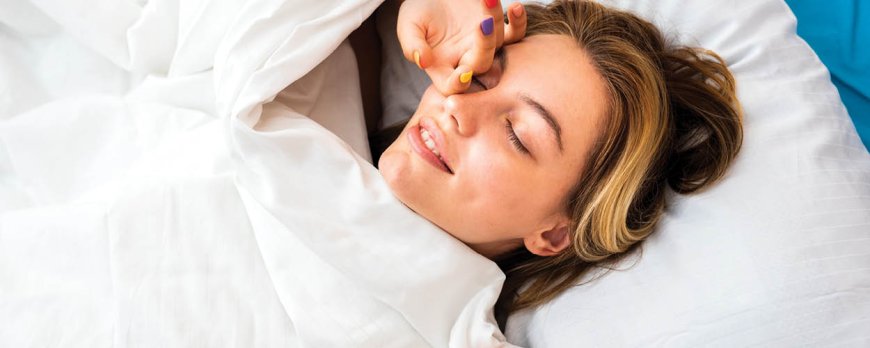How to have lucid dreams?
Discover the intriguing techniques of mastering lucid dreaming. Delve into our guide on 'How to have lucid dreams?' to unlock your subconscious potential.

How to Have Lucid Dreams?
If you've ever wanted to have control over your dreams and explore the depths of your subconscious mind, learning how to have lucid dreams is the key. Lucid dreaming is a fascinating phenomenon that allows individuals to be aware that they are dreaming while they are still in the dream state. This unique experience opens up a realm of possibilities for self-discovery, creativity, and personal growth.
Key Takeaways:
- Reality testing, such as performing tests throughout the day, can help differentiate between sleep and waking states, increasing the chances of having lucid dreams.
- Mnemonic induction of lucid dreams (MILD) involves training oneself to recognize the difference between dreams and reality during sleep, enhancing the ability to have lucid dreams.
- Wake back to bed (WBTB) is a technique where you wake up in the middle of the night and then go back to sleep after some time, increasing the likelihood of experiencing lucid dreams.
- External stimulation, such as flashing lights or audio cues, can be used to induce lucid dreams by affecting the dream state.
- Keeping a dream journal and practicing good sleep hygiene, such as maintaining a consistent sleep routine, can improve dream recall and increase the chances of having lucid dreams.
While there are potential benefits to lucid dreaming, such as overcoming fears and treating nightmares, it is important to note that there is ongoing debate regarding the impact of lucid dreaming on mental health and sleep quality. Frequent lucid dreaming may disrupt sleep patterns and affect overall sleep quality. Further research is necessary to fully understand the phenomenon of lucid dreaming and its effects.
Understanding Lucid Dreaming
Lucid dreaming is a phenomenon in which the dreamer becomes aware that they are dreaming, allowing them to actively participate and manipulate the dream world. It is a state of consciousness that offers unique opportunities for creativity, self-exploration, and personal growth. But what are the benefits of lucid dreaming, and how can you improve your dream recall to have more lucid dreams?
Benefits of Lucid Dreaming:
- Enhanced creativity: Lucid dreaming provides a platform for exploring and harnessing your creative abilities without the limitations of the waking world.
- Personal growth: By consciously navigating your dreams, you can gain insights into your subconscious mind and uncover hidden desires, fears, and emotions.
- Overcoming fears and nightmares: Lucid dreaming enables you to confront and overcome fears and nightmares in a safe, controlled environment.
Enhancing Dream Recall:
Improving your dream recall is essential for increasing the frequency of lucid dreams. Here are some tips to help you remember your dreams more vividly:
- Keep a dream journal: Keep a notebook and pen next to your bed to jot down your dreams as soon as you wake up. This practice strengthens the connection between your dreaming and waking states, making it easier to recall dreams.
- Create a bedtime routine: Establish a calming bedtime routine that includes relaxation techniques, such as meditation or deep breathing, to promote better dream recall.
- Set intention before sleep: Before falling asleep, set a clear intention to remember your dreams. Repeat affirmations or visualize yourself becoming aware in your dreams.
By understanding the benefits of lucid dreaming and improving your dream recall, you can take the first steps toward experiencing this extraordinary phenomenon. In the following sections, we will explore different techniques, such as reality testing and mnemonic induction of lucid dreams, that can further enhance your ability to have lucid dreams.

Reality Testing for Lucid Dreaming
Reality testing is a powerful technique that can help you become aware of when you are dreaming, leading to lucid dreams. By performing reality checks throughout the day, you train your mind to question your reality and distinguish between sleep and waking states. These reality checks can serve as reminders to critically evaluate your surroundings, supporting the development of lucid dreaming skills.
There are several effective reality check methods you can incorporate into your daily routine. One popular method is the "finger through the palm" test. Throughout the day, take a moment to try pushing one finger through the palm of your opposite hand. In a dream, this action may be possible, but in waking life, it is not. By regularly practicing this reality check, you increase the likelihood of performing it while dreaming, triggering lucidity.
Another reality check technique involves examining digital clocks or text. In dreams, these elements often appear blurry or constantly changing. By habitually looking at digital displays and reading text with intention and focus, you can cultivate the habit of doing the same in your dreams, leading to conscious awareness and lucidity.
Remember that consistency is key when it comes to reality testing. Gradually integrate these reality checks into your daily life, making them a natural part of your routine. As you become more skilled at reality testing, you will increase your chances of having lucid dreams and experiencing the amazing benefits that come with them.
Mnemonic Induction of Lucid Dreams (MILD)
Mnemonic Induction of Lucid Dreams (MILD) is a technique that focuses on improving dream awareness and enhancing the likelihood of having lucid dreams. It involves training oneself to recognize the difference between dreams and reality during sleep, ultimately enabling individuals to become more conscious and in control of their dreams.
One of the key components of MILD is the use of a mnemonic or a mental prompt to remind oneself to recognize when they are dreaming. This can be done through repetition of a specific phrase or affirmation before falling asleep, such as "I will remember that I am dreaming." By constantly reinforcing this intention, it becomes more likely to carry over into the dream state, increasing the chances of achieving lucidity.
Another aspect of MILD is the practice of "reality testing" throughout the day. This involves performing simple tests or checks that can help differentiate between waking reality and the dream state. Examples of reality tests include looking at a clock or a text, looking away, and then looking back again to see if anything has changed. By consistently performing these reality checks, individuals can develop a habit of questioning their reality, which can carry over into their dreams, leading to lucid experiences.
Benefits of MILD:
- Improves dream awareness
- Enhances the likelihood of having lucid dreams
- Increases control and agency within dreams
It's important to note that mastering MILD may take time and practice. The effectiveness of this technique can vary from person to person, so it's essential to remain patient and consistent in its application. Additionally, combining MILD with other techniques, such as keeping a dream journal or practicing good sleep hygiene, can further enhance the chances of having lucid dreams.
While lucid dreaming can offer potential benefits, like overcoming fears or treating nightmares, there is ongoing debate regarding its impact on mental health. Some argue that frequent lucid dreaming may disrupt sleep and affect sleep quality, while others emphasize the positive psychological effects of lucidity. Further research is needed to fully understand the phenomenon of lucid dreaming and its effects on mental well-being.

Wake Back to Bed (WBTB)
Wake Back to Bed (WBTB) is a popular technique that involves briefly waking up during the night to induce lucid dreams. By setting an alarm clock to wake you up after a few hours of sleep, you interrupt your normal sleep pattern and increase your chances of becoming aware within your dreams. The interruption helps to bridge the gap between deep sleep and the REM (rapid eye movement) stage, which is where dreams primarily occur.
Here are some key steps to follow when practicing the WBTB technique:
- Set an alarm clock to wake you up after approximately 4 to 6 hours of sleep.
- When the alarm goes off, try to remain calm and avoid engaging in any stimulating activities that may fully wake you up.
- Stay awake for about 20 to 30 minutes, engaging in quiet and relaxing activities, such as reading about lucid dreaming or focusing on your intention to have a lucid dream.
- After the allocated time, return to bed and make a conscious effort to maintain awareness as you drift back to sleep.
It's important to note that the duration of wakefulness during the WBTB technique may vary for each individual. Some may find success with shorter periods of wakefulness, while others might benefit from longer intervals. Experimentation and personal preference can help determine the optimal timing for this technique.
Give the WBTB technique a try and see if it works for you. Remember, inducing lucid dreams requires practice, patience, and a combination of various techniques. With persistence and dedication, you can enhance your ability to have lucid dreams and explore the limitless possibilities within the dream world.
External Stimulation for Lucid Dreaming
External stimulation can be a powerful tool to induce and enhance lucid dreaming experiences. By incorporating various external stimuli into your sleep environment, you can increase your chances of becoming aware and in control of your dreams. Here are some techniques that utilize external stimulation:
- Flashing lights: Using a device that emits intermittent flashes of light, such as a light therapy lamp or a specialized lucid dreaming mask, can help trigger lucidity in dreams. As you sleep, these lights can appear within your dreams, signaling that you are dreaming and prompting you to become lucid.
- Audio cues: Playing specific sounds or music designed to induce lucid dreaming can have a similar effect as flashing lights. There are audio tracks available that incorporate binaural beats or isochronic tones, which are believed to synchronize brainwaves and promote lucidity during sleep.
- Subliminal messaging: Using subliminal messages during sleep can also be an effective way to enhance lucid dreaming. These messages are embedded in audio recordings or visual stimuli that are played or displayed during sleep. The subconscious mind can pick up on these messages, potentially increasing the likelihood of becoming lucid in dreams.
It is important to note that while external stimulation can be a valuable aid in lucid dreaming, it may not work for everyone. Each individual's experiences and responses to different techniques may vary. It is recommended to experiment with different methods and find what works best for you.
Remember, the ultimate goal of utilizing external stimulation is to become more aware and in control of your dreams. Lucid dreaming can provide unique opportunities for exploration, creativity, and personal growth. However, it is essential to maintain a healthy sleep routine and practice good sleep hygiene to ensure overall well-being and sleep quality.

Keeping a Dream Journal and Sleep Hygiene
Keeping a dream journal and practicing good sleep hygiene are essential habits for anyone looking to have lucid dreams. A dream journal serves as a valuable tool for recording and analyzing your dreams, allowing you to identify patterns and themes that may indicate when you are in a dream state. By writing down your dreams immediately upon waking, you are more likely to remember them in vivid detail, which can enhance your overall dream recall and increase the chances of having lucid dreams.
To maintain a dream journal, keep a notebook and pen next to your bed, or use a dream journal app on your smartphone. As soon as you wake up, before engaging in any other activities, take a few moments to recall your dream and write down the key details. Be sure to include any emotions, locations, and characters that stood out to you. The more consistent you are in recording your dreams, the more likely you are to notice recurring themes and trigger your awareness during dream states.
In addition to keeping a dream journal, practicing good sleep hygiene is crucial for optimizing your chances of having lucid dreams. Sleep hygiene involves creating a conducive sleep environment and establishing a regular sleep routine. Ensure that your bedroom is cool, dark, and quiet to promote deep and restful sleep. Avoid consuming caffeine or engaging in stimulating activities close to bedtime. Instead, develop a relaxing bedtime routine, such as reading a book, taking a warm bath, or practicing meditation to prepare your mind and body for sleep.
To further enhance your sleep hygiene, prioritize getting an adequate amount of sleep each night. Aim for seven to eight hours of uninterrupted sleep to promote optimal brain function and increase your chances of achieving lucid dreams. By making these habits a regular part of your sleep routine, you can create a conducive environment for experiencing vivid and lucid dreams.
Potential Benefits and Considerations of Lucid Dreaming
While lucid dreaming can offer potential benefits, it is important to consider its effects on mental health and sleep patterns. Here are some key points to consider:
- Lucid dreaming benefits: Lucid dreaming has the potential to be a transformative experience. It can provide a platform for personal growth, self-discovery, and creative exploration. Many people use lucid dreaming as a tool to overcome fears, practice new skills, and enhance problem-solving abilities within the dream realm.
- Mental health: While lucid dreaming can have positive effects on mental well-being, it is crucial to approach it with mindfulness and self-awareness. Some individuals may find that lucid dreaming exacerbates certain mental health conditions, such as anxiety or post-traumatic stress disorder. It is important to consult with a healthcare professional if you have any concerns about the impact of lucid dreaming on your mental health.
Considerations for Mental Health
- Sleep disruption: Frequent lucid dreaming may disrupt normal sleep patterns, leading to fatigue and decreased sleep quality. It is essential to prioritize adequate rest and ensure that lucid dreaming does not interfere with overall sleep hygiene.
However, further research is needed to fully understand the potential risks and benefits of lucid dreaming on mental health and sleep disruption.
Lucid dreaming is a fascinating phenomenon with the potential to offer tremendous personal growth and exploration. By practicing various techniques, such as reality testing, mnemonic induction of lucid dreams (MILD), wake back to bed (WBTB), and external stimulation, individuals can increase their chances of having lucid dreams. Keeping a dream journal and incorporating good sleep hygiene can further enhance dream recall and the overall quality of lucid dreaming experiences. While there are potential benefits to lucid dreaming, it is crucial to consider its effects on mental health and sleep patterns. By approaching lucid dreaming with mindfulness and self-awareness, individuals can navigate the dream realm safely and harness its transformative potential.

Conclusion
Mastering the art of lucid dreaming requires dedication and practice, but the potential rewards for exploring your subconscious mind are truly fascinating.
To have lucid dreams, various techniques can be used. Reality testing is one such method that involves performing tests throughout the day to differentiate between sleep and waking. By consistently questioning your reality, you can increase your chances of becoming lucid in your dreams.
Another effective technique is mnemonic induction of lucid dreams (MILD), which involves training yourself to recognize the difference between dreams and reality during sleep. Through visualization and affirmation, MILD can enhance your awareness within the dream state and enable lucidity.
Wake back to bed (WBTB) is a technique where you wake up in the middle of the night and then go back to sleep after some time. This method capitalizes on the naturally increased likelihood of entering a dream during the REM (rapid eye movement) stage of sleep, thus increasing the probability of having lucid dreams.
External stimulation can also be employed to induce lucid dreams. Techniques such as using flashing lights or audio cues during sleep have been found to enhance the likelihood of achieving lucidity. These stimuli can act as dream signs and trigger your consciousness within the dream realm.
Keeping a dream journal and practicing good sleep hygiene are additional ways to increase the likelihood of having lucid dreams. By recording your dreams in a journal and adopting healthy sleep habits, such as maintaining a consistent sleep schedule and creating a peaceful sleep environment, you can improve dream recall and create favorable conditions for lucidity.
It is important to note that inducing lucid dreams can have potential benefits, such as overcoming fears and treating nightmares. However, there is also debate over whether frequent lucid dreaming may disrupt sleep and affect sleep quality. More research is needed to fully understand the phenomenon of lucid dreaming and its effects on mental health.
In conclusion, while achieving lucid dreams may require effort and persistence, the exploration of your subconscious mind can open up a world of limitless possibilities. By incorporating various techniques and cultivating a curious mindset, you can embark on a journey of self-discovery and unlock the wonders of lucid dreaming.
FAQ
How can I have lucid dreams?
There are various techniques that can be used to induce lucid dreams. These include reality testing, mnemonic induction of lucid dreams (MILD), wake back to bed (WBTB), external stimulation, keeping a dream journal, and practicing good sleep hygiene.
What is reality testing for lucid dreaming?
Reality testing is a technique that involves performing tests throughout the day to differentiate between sleep and waking. By regularly checking if you are dreaming or awake, you can increase your chances of recognizing when you are in a dream and become lucid.
What is mnemonic induction of lucid dreams (MILD)?
MILD is a technique where you train yourself to recognize the difference between dreams and reality during sleep. This involves affirmations and visualization before falling asleep, with the intention of becoming aware and lucid when you are dreaming.
What is wake back to bed (WBTB)?
WBTB is a technique where you wake up in the middle of the night, stay awake for a short period, and then go back to sleep. This interruption in your sleep pattern can increase the likelihood of having lucid dreams during the subsequent sleep period.
How can external stimulation induce lucid dreams?
External stimulation, such as flashing lights or audio cues, can be used to induce lucid dreams. These stimuli can affect the dream state and increase the chances of becoming aware and lucid during your dreams.
Why is keeping a dream journal and practicing good sleep hygiene important for lucid dreaming?
Keeping a dream journal helps improve dream recall, allowing you to better remember and analyze your dreams. Practicing good sleep hygiene, such as maintaining a regular sleep schedule and creating a conducive sleep environment, can enhance the overall quality of your sleep and increase the chances of having lucid dreams.
What are the potential benefits and considerations of lucid dreaming?
Lucid dreaming has potential benefits such as overcoming fears and treating nightmares. However, there is a debate over whether it is beneficial or harmful to mental health. Frequent lucid dreaming may disrupt sleep and affect sleep quality. Further research is needed to fully understand the phenomenon of lucid dreaming and its effects.
































































































































